-
Posts
1,999 -
Joined
-
Last visited
Content Type
Profiles
Forums
Store
Help Articles
Posts posted by Peter Green
-
-
the Coroner's Lunch by Colin Cotterill. A mystery, but with great descriptions of baguettes in Vientiane (Christopher Moore recommended this, and it's a very good read).
-
I've got a plan.
Remember, if you fail to plan, you plan to fail.
I flail when I plan.
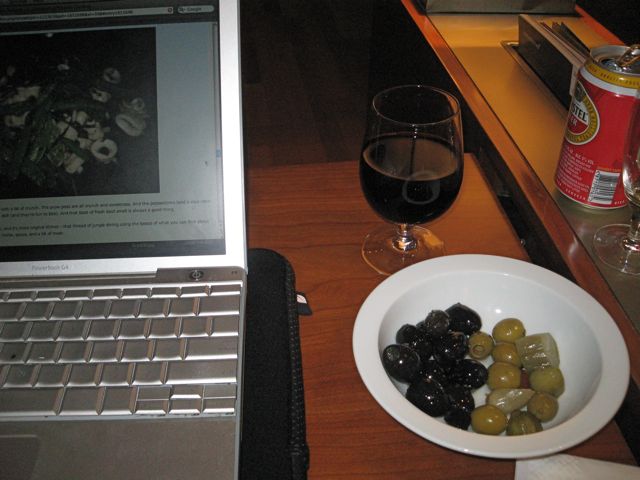
I'm back in an airport lounge again, with hours of leisure stretching before me (up until the part in which I engage in the local equivalent of the running of the bulls, which is also known as boarding.
I've a glass of something red from France, and a bowl of very good olives, which I'll need to replenish. The blacks feel Egyptian (maybe Lebanese?) with a soft mush to them. The greens are crisp and airy, probably Turks. There are some Egyptian style pickles out there, too.
The BBC is running a very good program on Viktor ("'Bout time") the gun runner whom the Thai have as a guest of the state right now, so you'll pardon me if I divert my attention from time to time. They took him down on a sting involving the FARC, so this overlaps a number of my interests.
Anyways, a plan.
To start, as I've said, we'll do a quick drop in on Bangkok. I'll see FlyingRat and the usual suspects, and get in a couple of good meals.
The next morning, I should arrive in Seoul, with The Boy showing up some hours later. He, Jason, and I intend to do some serious damage for a couple of weeks.
After that, it will be back to Bangkok for an idyll (of sorts), to be joined by Yoonhi and Serena and sundry family members.
Then we'll be back to my beloved Luang Prabang for Pimai, the Lao New Year.
At some point I have to go back to work.
But, the good news (I think
 ) is that I'll leave on business shortly after that.
) is that I'll leave on business shortly after that.Will I ever manage to finish writing this up?
-
The pad thai looks strangely pale. How was it? I still like Pim's recipe on Chez Pim or the one on Thai Table. Mostly nowadays I cheat and use the paste *hides* please don't tell my Aunties.
Yes, it's not the usual ruddy hue, but the flavour is quite good. I pick up more of the sriracha and the vinegar and soy. I may try doubling the volume of sauce, and playing with different brands of sriracha.
Of course, I'd need a kitchen for that.
-
The Sichuan bean starch - what is it made from? Is it available in North America? If not, I could get my students to find it for me when they go home to China during the term break. If you have a picture, that would be very helpful.
Dejah,
Here’s a shot of the package of starch I’ve been using.
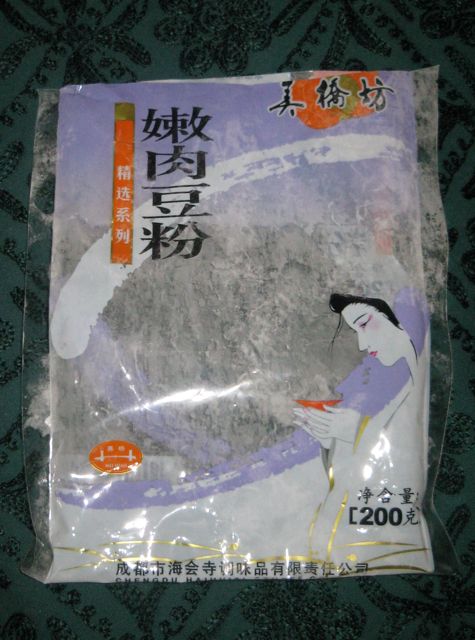
Good luck on finding it, and thanks. I’d been meaning to get a picture on file for some of my Chinese friends to see if they can replenish me.
(and if anyone out there knows a place in Vancouver with this, I'd love to know!)
-
My bags are packed, I'm ready to go........
This is going to be a long one. First, I have to change planes in Bangkok, and with about 16 hours between flights, there'll be some eating to do.
-
Okay, I lied. I had two meals left in me.
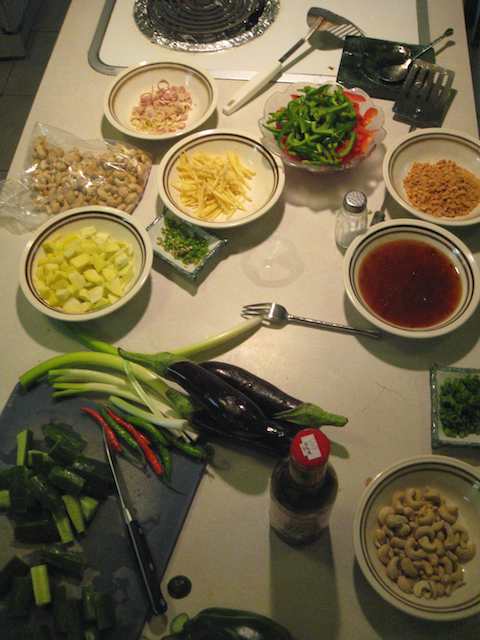
It was another group feed last night, and I used the opportunity to take a second look at what I'd been playing with. However, going slightly off topic, Yoonhi did have me stray from a purely Khmer theme.

First up was a pomelo and prawn salad. Very similar to a Thai yam som o, but specifically lacking the chili peppers in the dressing. Otherwise it was cooked prawns, shredded pomelo, mint, lemon grass, coriander, cucumbers for crunch, and some spring onions and shallots. The dressing was lime, nampla, and palm sugar. As Joannes says, "an elegant citrus and shrimp salad".
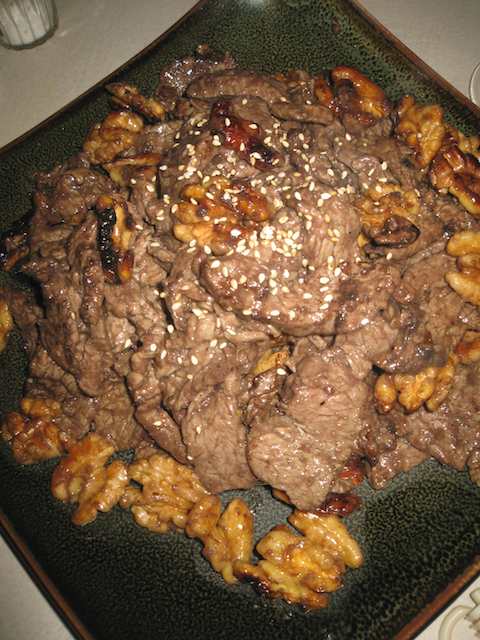
I strayed way North for the meat dish, heading into China for fengmi niulijirou hetaoren - honey-glazed beef and walnuts. Off theme, but I'm going to be gone for awhile, and this is what Yoonhi wanted me to cook for her. Keep your wife happy, say I, and life will be good.
For this I dipped into my dwindling stock of Sichuan bean starch. That stuff has some form of papane in it that works marvels in tenderizing the meat in s a short time. The meat is marinated in soy, egg, water, starch, and five-spice powder, and left to sit for about 20 minutes. Then it's fried in oil, removed to drain, the walnuts are fried, and they're removed to drain, and then you wait until the last minute to reduce the sauce of honey, mirin, soy sauce, black vinegar, salt, and ginger juice (as a note, I find that using a cheese grater to rip up my ginger first makes the juicing dead easy).
As another note, it's interesting to compare the use of ginger as a flavour element in sauces and marinades against the Khmer attitude of treating it as a vegetable.
A little roasted sesame seed on top, and this was very, very good. The meat just melted on the tongue (I squirreled a little away on a separate plate for myself before I sent it out to the table).

I revisited the sweet sour fish with green mango. A snapper would have worked better for the frying, but it wasn't available, so I went with grouper. I do like the meat on the grouper better, but it's a far thicker fish to be pre-frying. Still, this recipe will work, given that the fish is cooked twice - once fried, and the second time heating in the sauce. For the sauce, I increased the amount of sugar, and spent more time in getting a better caramel, gettting more stickiness out of it. I would go with this working over the lighter approach with the tilapia I'd done earlier (plus, how many tilapia would I have to do? One for each couple?).
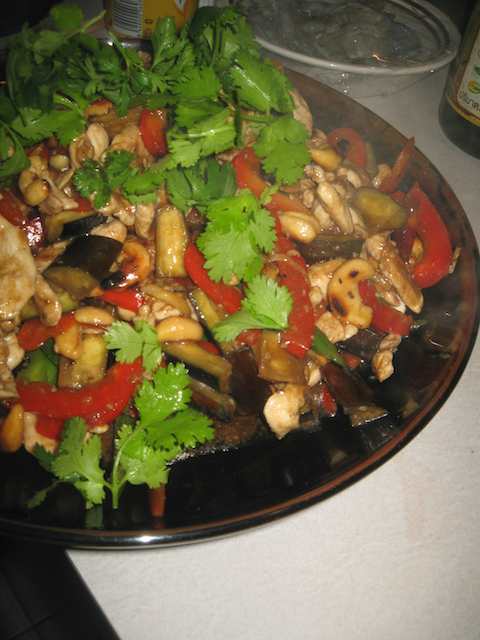
I didn't change too much on the chicken with dried chilies and cashews. As an aesthetic item, I added red bell peppers to the green, wanting a little more colour contrast in the dish. The other change was to quarter the eggplant. I like the flavour, and the texture of the skin, but there was too much skin when they were just cut in half-rounds. This way, quartered, the balance of flesh vs skin felt just right.
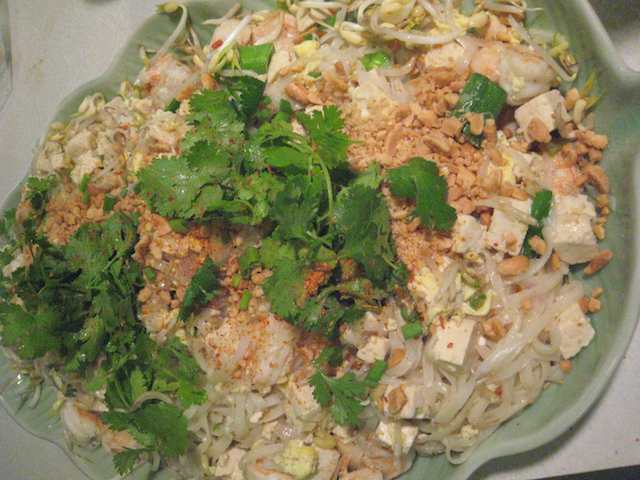
We finished the main courses with a drift away from Khmer, to Thai, with a phad Thai. I've been playing lately with Import Thai's recipe. For this, the sauce of sugar, nam pla, tamarind, and sriracha is cooked ahead and held ready. The egg is scrambled and set aside, and the prawns are also fried and set aside. Shallots, pickled radish, and tofu are then fried in the walk, and the noodles come in shortly after, softening in the wok. Once they're settled, in goes the egg, prawns, some chives, and the bean sprouts. Serve with a sprinkle of peanuts and raw sprouts, and we have a good roll-off.
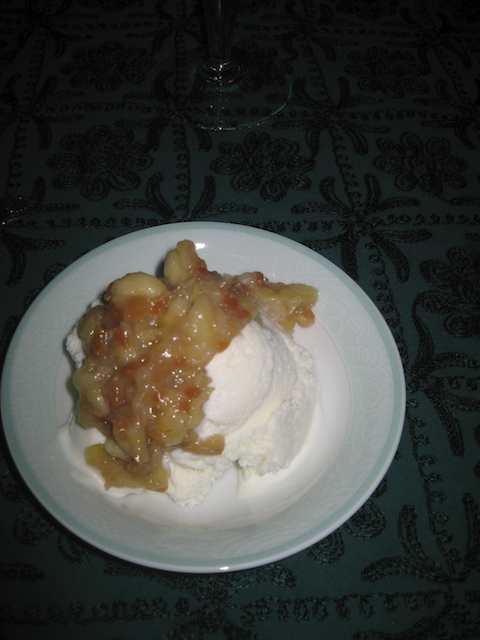
Serena and I had been leering at the book's picture of coconut ice cream with caramelized bananas. The "ice cream" is neat, using coconut milk, sweetened condensed milk, and light cream, with only a couple of teaspoons of sugar. With the condensed milk, you don't need much else, I would think. A little light cream to round it off, a bit of a beating, and we'd put this into the ice cream attachment on the KitchenAide in the morning, and then left it in the freezer to set.
The caramelized bananas were a mash of bananas, salt, peanuts, and water which were boiled over medium heat. You just get it to caramelize, with a thick syrup, let it come off of the heat, and then plop it onto the ice cream.
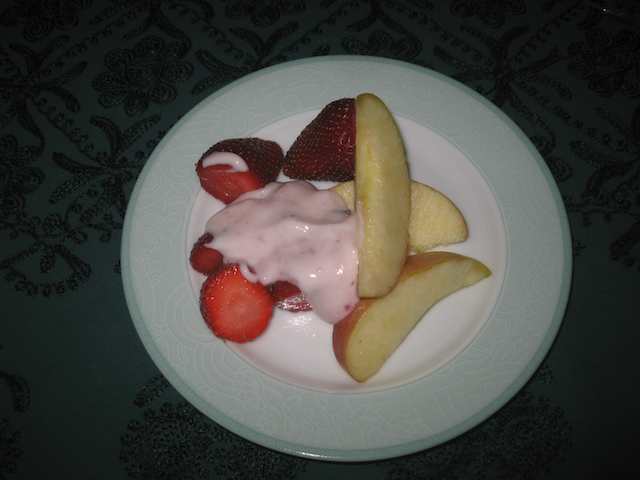
And, in Asia you finish with fruit, so our friends brought home made yogurt and some fresh strawberries and apples.
A successful meal. That means that no one had to be rushed to the hospital, there were no fights, and I have leftovers to eat for breakfast.
Now, I'd better start packing.
-
In my opinion......
You'll never find a "book" that will demystify the brands. We're at a point now where new brands are popping up at a very satisfying rate. The market is just that way.
For me, if I need specific material explained, I'll just post the question here on eGullet, and the answers will come.
What more do you need?
"If you post it, they will come"
-
Peter: You know what, I've never had ink pasta before (not quite sure if this strange or not). Does it taste any different from the norm? Also, does it stain your teeth? haha
It can leave a goth tinge around the teeth, but what's interesting is the hue it imparts to my wooden spoons.
Still, it's not as bad as the black rice stains.

-
Friends were over from abroad last night, so we called up our common acquaintances and got everyone back together for an evening.
The starter was a Thai salad of fresh greens and grilled tenderloin. Unfortunately, this was inhaled before I could get off a picture. The salad portion consisted of endives, romaine lettuce, dill, coriander, mint, and anything else that wasn't moving fast enough in the crisper.
The dressing was standard Thai. Palm sugar, lime juice, nampla, chlis. I deseeded the chilis to ensure that my guests didn't howl (too much).
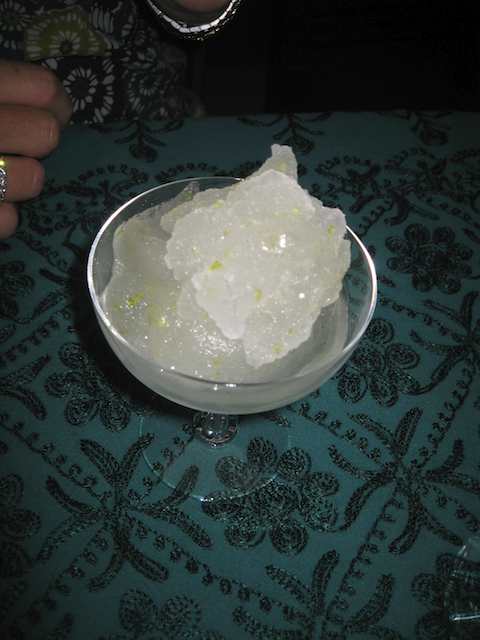
Then we ran a palate cleanser, a G&T sorbet. A bit of honey in there to sweeten the basic ingredients, and the zest of three limes and their juice.
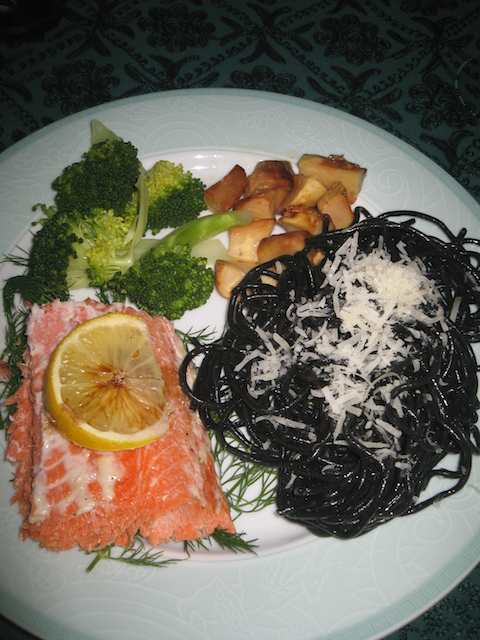
The main course was an attempt to clear out some of the freezer and pantry. I had the ink pasta sitting there for some time, so this seemed like the moment to use it up. A bit of parmesan shredded on top.
The salmon was one of the ones I hauled back from Vancouver in December, served on a bed of dill for the smell. I topped it with a bit of lemon, and poured a light drizzle of 4 year old balsamic through that.
The broccoli was there for the colour, and to clear the differing fats of the fish, the cheese, and the fuqaa (Arabian desert truffles).
The truffles we cooked lightly in butter. It's one of those flavours you don't want to mess around with too much.
-
Khmer Curry
"Curry is a traditional Cambodian dish served on every important ceremonial occasion."
Keying on how important this dish is to Khmer customs, I made a botch of it.
Well, it's not so much a botch as I was missing some ingredients, and went at it anyways.
The first bit of business was to prepare the paste. I had my stash of Kroeung now, so that part was wasy. The rest was a matter of roasting star anise and coriander seeds, smashing them down, adding some dried chilis that had been soaking, smashing them down, add some shrimp paste and smash that down, and then add in a bunch of the Khmer curry paste and...well, you've got the pattern by now.
Next, the actual cooking.
My first foul was in not having any annatto seeds, a natural red food colouring. Our housekeeper usually has this around, as the Filipinos use this for the colour as well.
So, no red colour. I'll live.
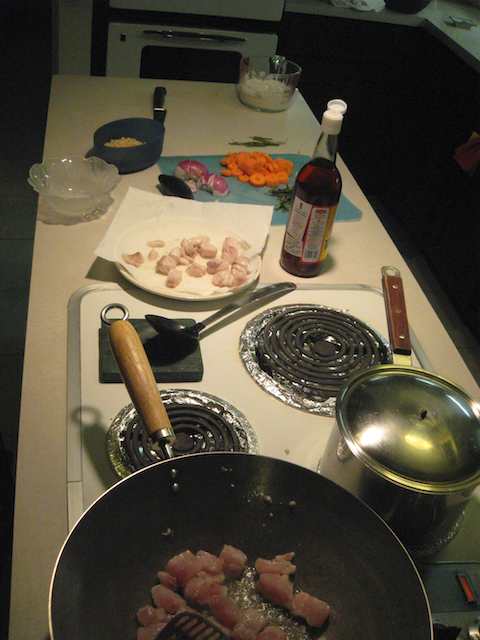
Next, we fried the fish and then set it aside to drain. Then fry the spice paste to a brown, and add kaffir lime leaves, carrots, onion fish sauce, and sugar.
I should also have added sweet potato at this time, as the Khmer curry is "distinct in Asia for their use of sweet potatoes".
That cooks to soften for 10 minutes, and then the fish, green beans, and eggplant go in and take another 5 minutes.
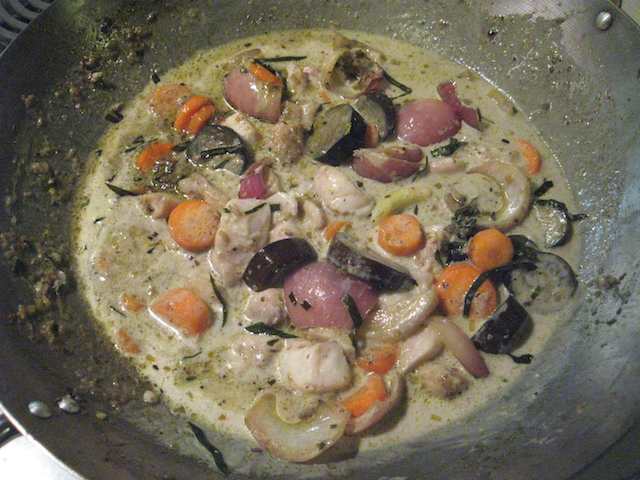
After that, two cups of coconut milk, bring it to a boil, and serve it.
The flavour is oily sweet, and very good with the rice. You can smell the anise and kaffir lime leaves in there.
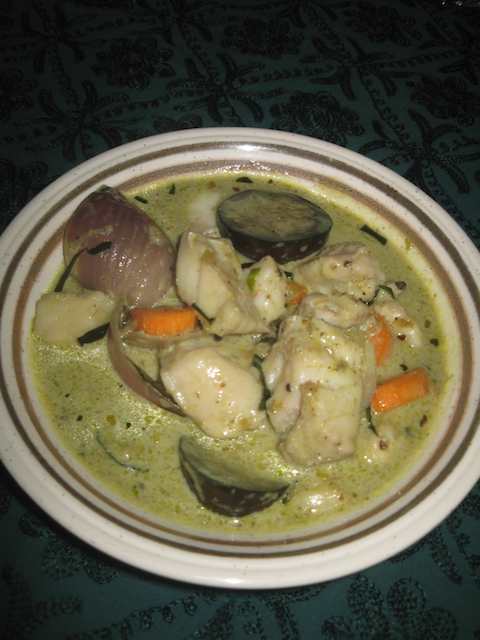
But it does come across as too salty, the effect of the fish sauce. If I'd had the potato in there, I suspect that would have tempered things somewhat.
I need to try this again with all the proper ingredients. As a curry, there's nothing to complain about here, the overall effect being much more Indian to me than South East Asian.
-
Groan...looks like I'll have to buy Joannes Riviere - Cambodian Cooking. The last dish with the green peppercorns just did me in.

I can almost taste that burst of pepper and basil. This dish has all my favourite ingredients and aromas.
I wonder if Rona knows where I can buy green peppercorns in Winnipeg...

Keep 'em coming, Peter. It's always great to have your pictorials to go along with the cookbook.
I also saw Elephant Walk in Amazon.ca. Whoa! Expensive!
Thanks, Dejah.
But I've probably only got one more Khmer meal in my kitchen for the next little while.
I have to start packing.
-
and if it's on the semi-firm (or firmer side) serve Khmer amok in it (the stewier kind). It's a wonderful thing to scrape out the meat with the amok.
-
Okay, this will be the last Khmer meal for a little while.
A quick meal for a work night......
Squid with Green Peppercorns
The recipe calls for fresh baby squid, but I'm making do with the teenagers I found in the freezer when I went hunting for my krachai the other day.
They also want green beans, trimmed and sliced, but I've got some snow peas, and I prefer those.
This is a relatively fast one.
First, we sliced up our squid, chopped the bottom 1/3 of 2 stalks of lemon grass, secured the garlic, juliened 5 kaffir lime leaves, and went hunting for the Malagassy green peppercorns I had in the fridge (many of you have seen my fridge.....it's not pretty).
I've still got some palm sugar ground up from the first day, and Yoonhi swiped a handful of basil leaves from the neighbor's bush.
Ready? Go!
Slap the squid into the wok on medium high mag induction for about 30 seconds, until it gives up its water. Remove the squid, bang in 3 tbsp of oil, and add the lemon grass and garlic. Stir fry for 1 minute. Then add the snow peas, kaffir lime leaves (ah, that smell), and then the green peppercorns and stir fry for another minute. Then put the squid back in, add the fish sauce and sugar, and stir fry for another minute. Rip the basil up, drop it in, remove from heat, and serve.
You can breathe now.
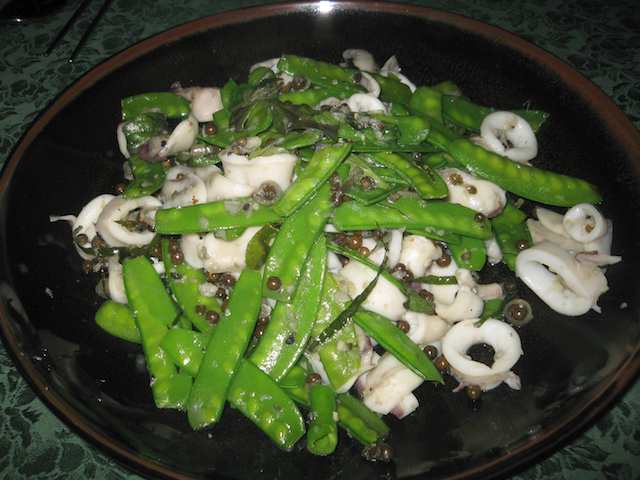
The squid is pliant, but still with a bit of crunch. The snow peas are all crunch and sweetness. And the peppercorns lend a slow rohn pet - peppery burn - to the dish (and they're fun to bite). And that blast of fresh basil smell is always a good thing.
You ask me about this dish, and it's more original Khmer - that thread of jungle dining using the basics of what you can find about you in the back of beyond. Herbs, spices, and a bit of meat.
I can do this again.
-
Moving right along to page 63....
Chicken with Dried Chilies and Cashews
This is definitely Chinese. Dried chilis and oyster sauce.
We start off soaking the dried chilis. The book says to remove the seeds, but after a few days of this, I'm beginning to crave heat in my food.
Next, out comes the stir fry gear. Some oil into the wok, the MI cranked to the max, and I sautee cashew nuts with the dried chili. Our housekeeper flees the kitchen, coughing.
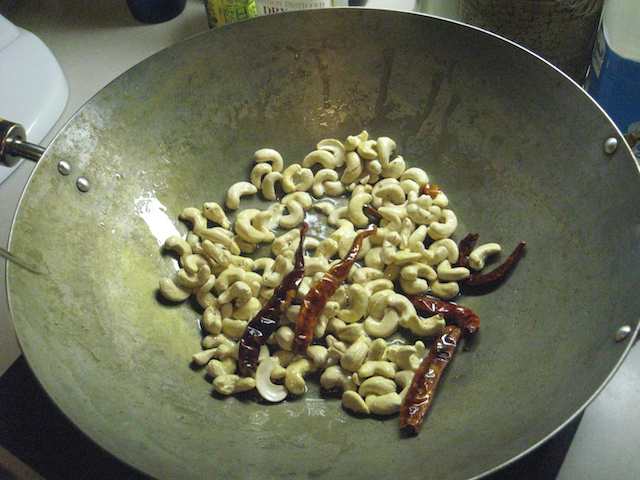
After the cashews go golden, I put in the ginger (shredded) to cook a little, and then add a good dollop of garlic, and my shredded chicken breast.
The book does advise, for stir fries, to cut the meat as close to the grain as possible so it doesn't dry out, but we couldn't find any boneless chicken breast, so we ended up shredding, which, by its nature, is going to be as close to the grain as you can get.
This cooks until the chicken browns, and then I toss in sliced eggplant and strips of green bell pepper. Cook for 2 minutes.
Now it's time for the sauce. 4 tablespoons of oyster sauce, and 2 tablespoons of soy sauce. Reduce that a bit, and serve it quick with a crown of coriander.
Biting into this, it's pleasant, and recognizable....barely.....I'm distracted by the eggplant, which I should have slice and quartered, rather than halved, which would have cut down on the skin, while leaving enough there still to give some contrast.
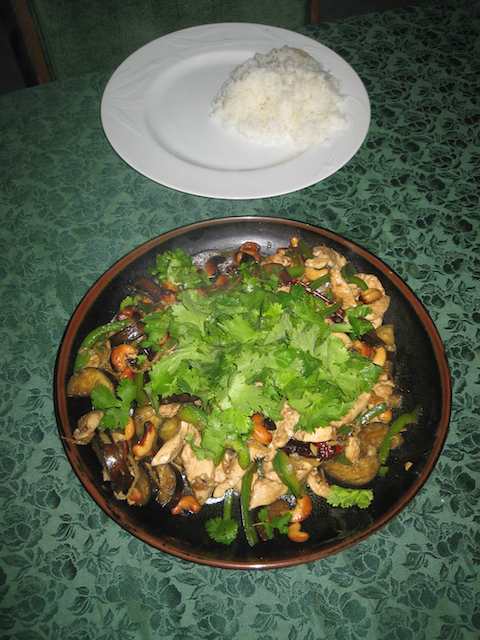
And then Yoonhi and I look at each other and say "kung pao chicken".
Jinx.
Okay, there are some differences, but if I'd cut things to a uniform size and shape, and left out the eggplant and cubed the ginger and added it later rather than earlier (remember, the Khmer cook ginger up front) and maybe tenderized the meat with that bean starch-papane thing......
It would've been kung pao chicken.
Yoonhi had to restrain me from getting my Sichuan peppercorns out.
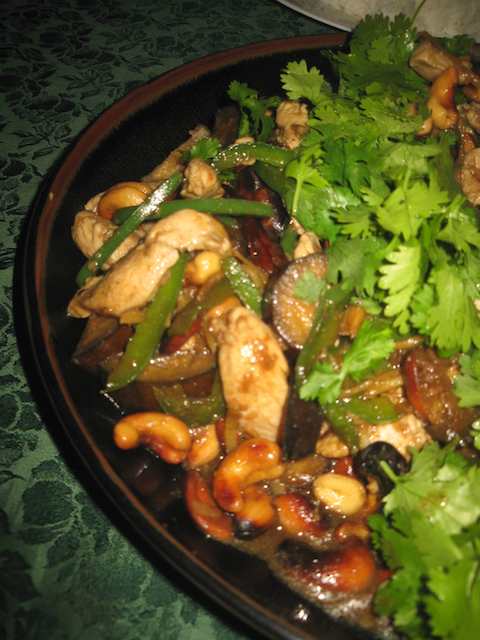
It's different enough, but still nice. The chili gives a nice warm burn around your mouth, without overpowering, and the cooking of the ginger as a shredded vegetable is really pleasant. Plus, Khmer style, you get a big nose of fresh coriander.
The oyster sauce would have come through the coastal trading routes, but the dish itself suggests a migration down the Maekhong.
Now I'm interested in going back to my Kung Pao recipe from Chengdu, and reworking things with a mix of this technique and those.
Life is too short for all the things we need to eat.

-
The second order of brains I ever ate was in Penh at what was then Restaurant 88. I remember it being soft, meltingly soft, as opposed to the fried things I'd had with Yoonhi at the William Tell in Vancouver way back when.
Hang Neak, across the Tonle and up along the banks of the Mekong always did really nice brains, steamed with fragrant herbs. And Ton Lok, on Sisowat Quay, was another good place (along with the "road frogs"). This is a dish that does well with the subdued flavours that the Khmer and the Chinese can bring to the table.
Now I want to go back and watch Sean of the Dead again.
-
Peter, thanks for report and good pix. I noticed suspiciously cheerful green color. Pure herbal products tend toward a paler green in my experience. shantytownbrown asked me: "Unless, from what I have recently learned, it is kept in a light protected (read dark glass) bottle; It is the light that degrades the chlorophyl to a brown color, and one should be wary of clear glass bottles containing absinthe that is bright green (read: color added)." Could be. What I know is I always see paler, often brown or yellow-tinged, green in quality absinthes, even very fresh, but a different color in cheap versions that also are less interesting flavorwise. And years ago I made an alcoholic spice macerate from mostly basil leaf, recommended for flavoring soups (from a formula book cited earlier -- Henley's), and it too had the paler, off-green color from the start. Such a leaf maceration step gives color to traditional absinthes.
I like that term: "suspiciously cheerful green".
I should have looked for colour addittives (not that it would have stopped us) but we checked for wormwood and left it at that.
I won't disagree. The post went in under the current topic of advertising in regards to absinthe, and this little packet seemed all about advertising. Eye catching green, mysterious eye, an attractive slotted spoon (with a great eye motif), instructions, and sugar all in a tidy plastic pouch. It secured my friend's attention.
Like I said, this didn't do much for me. If I compare this to what we drank in Shanghai it is a pale comparison (in an inverted manner).

-
"Tonight we're having ribs!.....Doh!"
I couldn't help myself. Across the page from the bbq'd beef skewers was Soy Glazed Spare Ribs with Star Anise
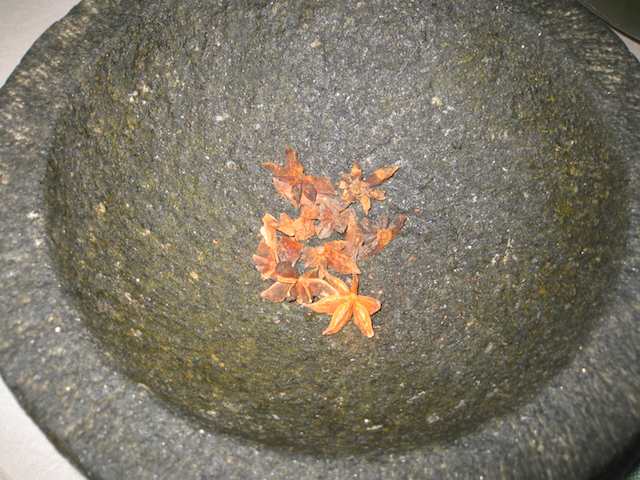
Now, star anise cries out to me of Vietnam, particularly South Vietnam (as opposed to the North). I wonder if this is something Cham in origin, but the pork cries out for Chinese merchants. You Vietnamese experts out there! What's your opinion?
First we prep a marinade. Star anise first (about half a dozen, pulled out of the stash), and then garlic, palm sugar (you can also use honey), and soy sauce. Mix that up, score the ribs, and let them sit for a couple of hours.
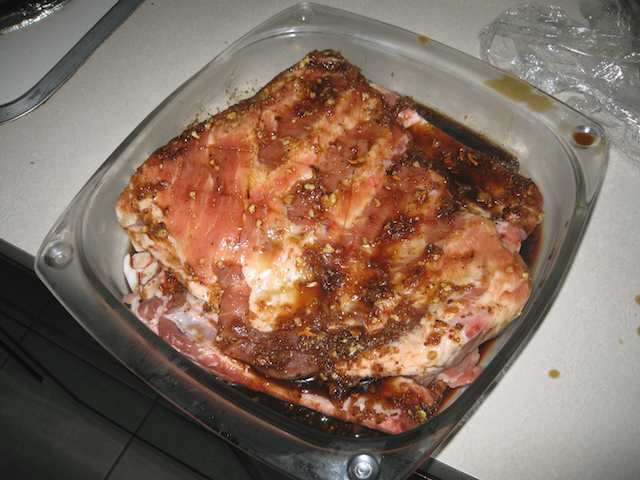
After the chicken, I decided to rely upon the smoker. Especially given that we're doing ribs, and I don't want to mess up something so precious.
I let them cook for four hours, topping up the water as we went. Part way through I tossed in some chicken wings that I had in the marinade, too, as Yoonhi said we needed some vegetables to go with the meal.
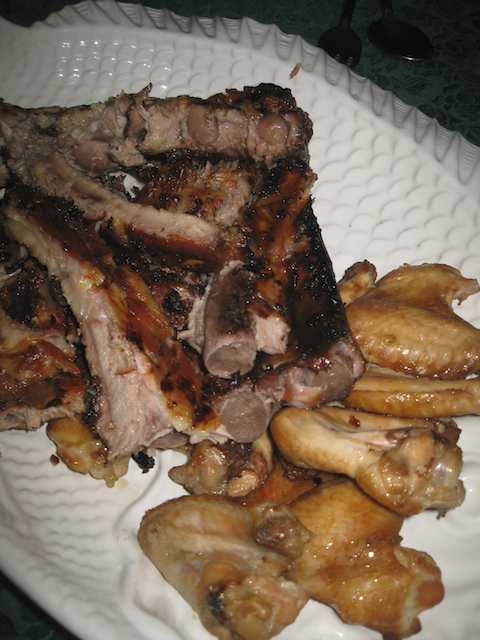
The results were mixed. The ribs were good. Moist, with a hint (but only a hint) of anise in the background. But ribs are (almost) always good, so had a made a wise decision?
I'd have to say, the Chinese recipes I have for ribs are probably better. But this was okay.
And the chicken was quite good. I could do more chicken like this (And I probably will).
P.S. - Yoonhi is still arguing that chicken isn't a vegetable, and insisted we put some green beans on the table.

-
Okay, I'm going to buy some banana leaves when I get back.
-
It's good to have a happy mom!
I have to ask, what was Sisowath Quay like? I'd heard it was ripped up and new infrastructure was being put in. Was it a mess, or did you get a chance for an espresso by the Maekhong?
-
The next day was Christmas! And what says Christmas more than a genocide museum!
That's my girl!
Tuol Sleng Genocide Museum is a place no one really wants to visit, but everyone should. It and the Killing Fields (which we did not visit) were the only reasons I wanted to go to Phnom Penh—not because I enjoy the macabre, but because I believe it’s important to confront all that we are capable of doing to one another. It’s probably best not to say more, but could someone tell me what this little boy did to deserve to be at that prison?They don't go into enough detail when going through these, but Tuol Sleng was important in that the victims here were KR as well. This was the upshot of the ideological split between the pro-Viet cadres and the real hardliners, who were bred "under the bombs" (so to speak) and in the cafes of Paris.
What I found particularly creepy about Tuol Sleng (as opposed to Chong Mek) are the photos. There's one they point out, where you can see the finger that crept in to tickle them, so they would smile for the camera.
When Yoonhi was here last, an older woman came bay, and went over the map. It was a map of Cambodia, with human skulls and bones. She had wandered through the country, collecting bones from all over the country, with that as her mission after her family was slaughtered.
The government took the map down a few years back, I understand.
Are these what I think they are?
Yes. Yes, they are.
There's another interesting word, too. Psah. "Psah" comes from "bazaar". Cambodia is an important source of Oudh for the Arabs (it's a rot found in woods, and used as incense), and has been on the trading route for this reason for a long, long time.
Rona, I've got to go back soon. Your pictures are making me miss the place again.
-
They come in different sizes....shipping a standard one would be quite expensive, I expect. I know a lot of people just use a lock & lock container. Do you want it for the look of it, or just to make kimchi in?
I'd come back to this question. What's the purpose? If it's aesthetic, then the suggestion to post in your local region is the best. Or find a local pottery concern that can make one to design. Shipping those puppies from Korea is going to be expensive.
If it's in order to make kimchi, then check out the kimchi fridges for sale through your local Korean store. A lot of the Koreans I know in Vancouver have one, as they reliably produce good kimchi (temperature and humidity control for the ferment).
And they're handy for storing beer, too.

-
Isn't that funny? According to my notes, there's no turmeric in my kroeung, but if you look in my picture of the ingredients, you can clearly see a little nub of it there. I have never found fresh turmeric outside of Vietnam, but if I was anywhere near some, I'd snap it up. It has a much better taste than the dried.
It's one of those things that's never there until you look for it. Once I was aware of it, I kept finding it in the markets all over Bangkok. I always drag some back with me now.
-
I thought amok was steamed like haw mok? It's more of a curry? Or did I miss something?
Ah, there's the rub! Amok seems to be more the combination of flavours - kroeung, coconut, nonnsi leaves. What you do with it is your choice, and you shouldn't feel confined to any one path.
There, my new thesis! The Tao of Amok.

-
I just went looking for a WGF reference on turmeric to add in for the last post, as it's a very interesting ingredient.
But, that was WGF 6 in Bangkok, and I didn't start posting until WGF7 (the earlier ones I just bored my close friends. Now I bore everyone).

This is such a neat ingredient, and it doesn't get enough press. As a key item in Khmer cooking, let's look at what Cyrus Todiwalla of Cafe Spice Namaste in London had to say (or rather, what I said he had to say - all errors are mine, not Cyrus'):
"Our other spice topic was turmeric. My main reaction to turmeric in the past has been an interest in the alacrity with which it manages to run through my system and come out my fingernails, making me look even more jaundiced than usual.
But, it appears, turmeric is the new wonder drug. It is one of the best disinfectants, killing all surface bacteria, and also a coagulent. When Cyrus cut himself on a knife awhile back, a quick dab of turmeric cleaned and clotted the wound quite nicely.
Talking with some of my Thai friends about this later, they agreed, it was an old folk remedy to rub turmeric on a wound. Likewise, if a child is hurt, they’ll feed them turmeric in a drink, to address possible internal injuries.
A jar of turmeric is also standard issue in most Indian autos, acting as a sealant for radiator failures. In breaking news, Cyrus noted that new research from the US indicates that it can stop the spread of breast cancer cells.
Coming back to cooking, it turns out that it is not only important for the colour it imparts, but also, as a coagulent, it will thicken the dishes in which it is used, working from the bottom up."
And that last bit helps to explain the thickening I found in the broth, without the normal aid of cornstarch or other items. This would also be the primary item in chu chi curries, which always come out with that wonderfully gloppy texture and colour.
And now, back to our regular programming.




Travelogue: Spring Break 2009 -- Bangkok
in Elsewhere in Asia/Pacific: Dining
Posted
I've come to rest in the KAL lounge, so my Scottish bloodline isn't likely to let me stray from free beer and wine.
However, I did notice in the central concourse that the sushi stand there in the middle of the passage had at least four, good looking big bottles of sake, and lots os shochu. If I was spending money to kill time, that's where I'd be.
I'll try to snag some shots when I come back through in late April. Right now I'll hang close to gate 7e.
Cheers,
Peter